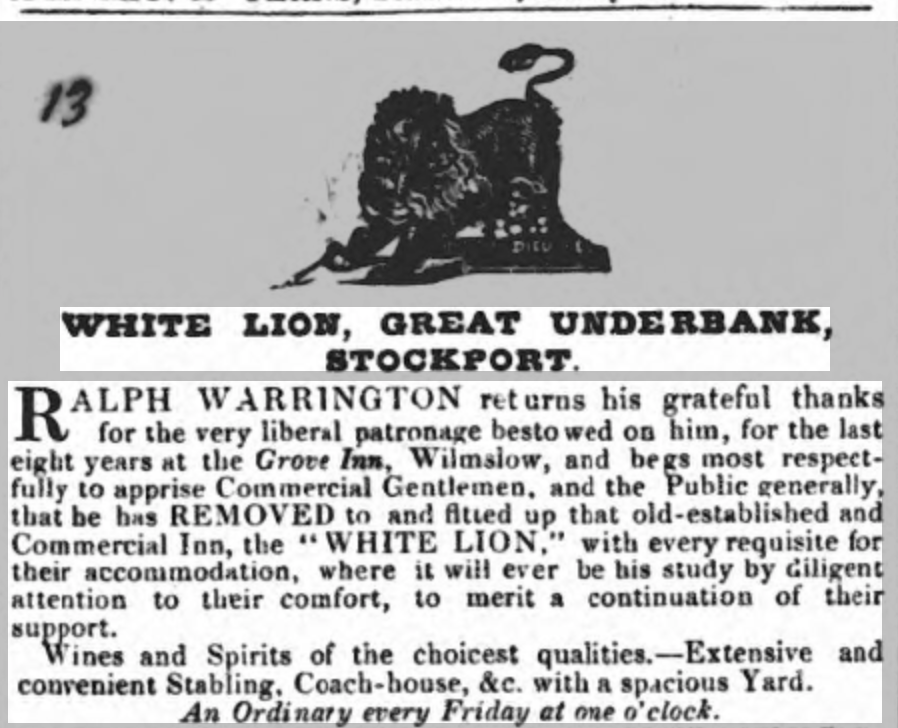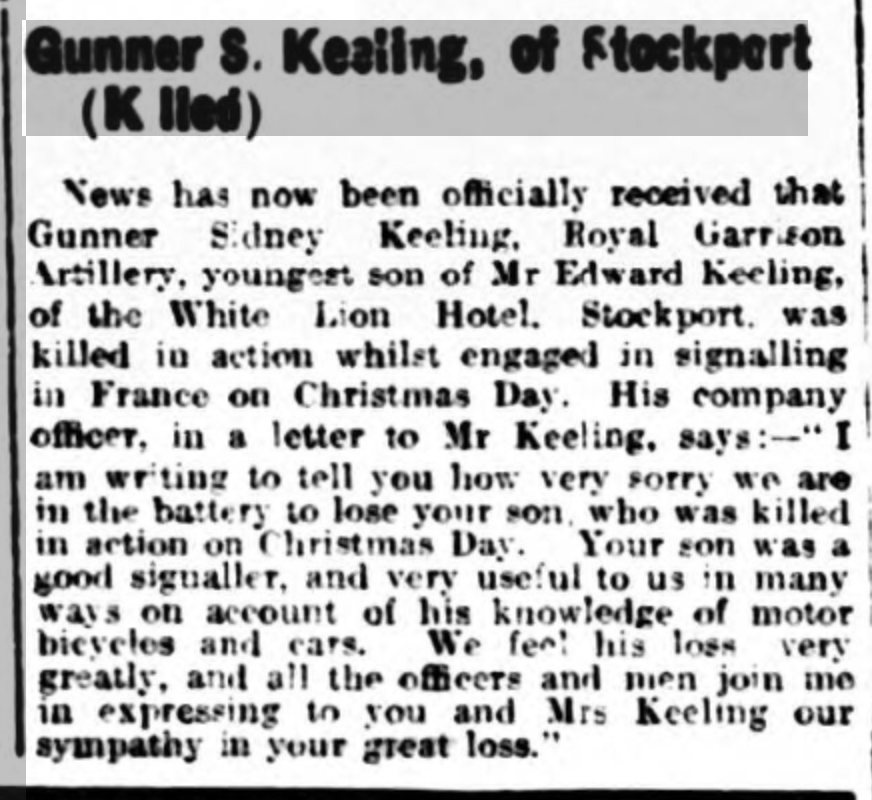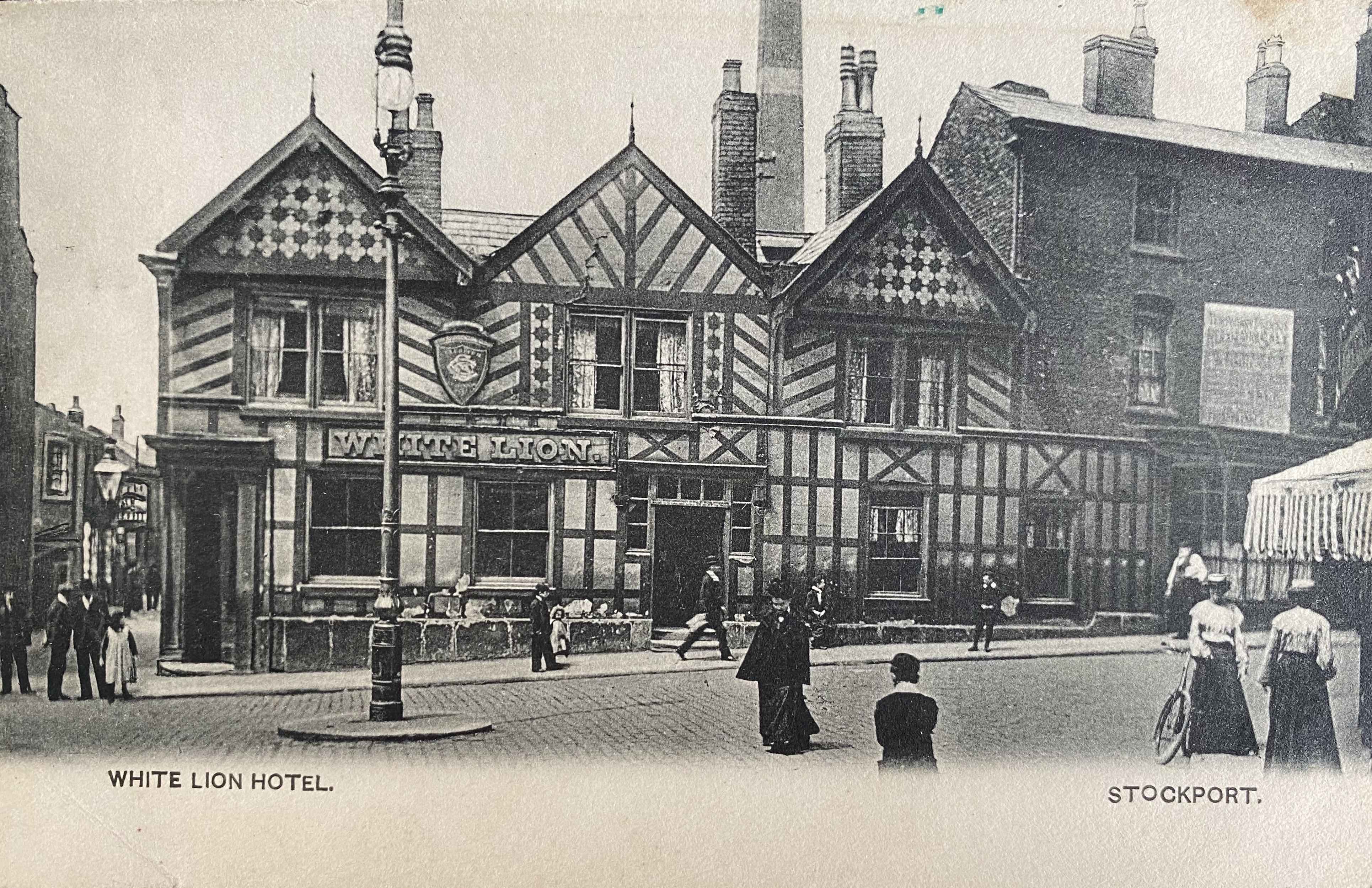
Apologies that this week’s blog is a bit late, my internet has been down for the best part of a week… *slides down wall*
So this week we have left Blackpool and are in my hometown of Stockport. The picture on the front of the postcard is of a pub called the White Lion, which is situated on Underbank. Now, there is a LOT of history to this pub – it was first granted a licence in the fourteenth century! Therefore, in my attempt not to write a book, I have decided to focus on its post-eighteenth-century history.
The date on the back of this week’s postcard is 1906. However, the picture of the White Lion on the front must pre-date this, as the pub no longer looked like this image in 1906. During the pub’s long history it was redesigned and rebuilt several times. The mock Tudor frontage that you can see in the picture was added in 1823. Not only did its appearance change over the decades, the White Lion evolved from a coaching inn to a hotel and then later a pub.
If you know anything about Victorian pubs, you will know that they did more than just serve beer. Alongside the selling of alcohol, the White Lion also acted as a meeting place, a coroner’s court, an auction house, a post house, a job centre (labour exchange), a place where organisations were formed and even a place where bankruptcies were heard. For example in June 1804, business partners James Roberts and Elisha Heawood were scheduled to attend the inn to disclose their estate and effects to the bankruptcy commissioners and to also face their creditors. It was common practice for people who could not afford to pay their debts to end up in a debtor’s prison. It was estimated that by the early nineteenth century, nearly half of all prisoners were debtors. Debtors continued to be imprisoned up to 1869 and only stopped being imprisoned following the passing of the Bankruptcy Act.
The first record that I came across that mentioned the White Lion, was a newspaper article from 1820. The article reported on the trial of Henry Hunt and nine others that were at present at the Peterloo Massacre. The ‘keeper’ of the White Lion at this time was a man named Henry Lomax, who was a member of the Cheshire Yeomanry and was present at the Massacre. Lomax had been called as a witness to testify against Henry Hunt. After a trial that lasted two weeks, Hunt was found guilty of ‘seditious intent’ and was sent to prison for two years. To learn more about Henry Hunt and the Peterloo Massacre, click here

The first family I can find living at the White Lion in the nineteenth century is the Birkin Family. I don’t know an awful lot about this family, in fact, I am not even convinced that ‘Birkin’ is their actual name. The only information I have on the family is from a newspaper article dated 1825 that mentions a ‘Mr Birkin’ being the landlord of the White Lion Inn, Stockport. The article tells the tragic story of an inquest that was held at the inn. The victim was Sarah Brookes, who was the sister of the landlord and was staying with the couple at the time of her death. Her death occurred when she was kneeling down lighting the morning fire in the sitting-room, and the blue apron she was wearing caught fire. She managed to get up, untie the apron, and fling it on the floor, however, it was too late. Within seconds everything else she was wearing was engulfed in flames. Upon hearing her screams, Mrs Birkin came to her aid with a blanket. She continuously rolled her sister in the blanket until all the flames were extinguished. Sarah survived the night but died the following day. Reporting her death, the newspaper stated that ‘her sufferings were happily ended by death’.
The next occupants of the White Lion were the Lomas Family. Henry Lomas and his family lived at the address from the late 1820s. On 21 February 1834, Henry Lomas sadly died. He was 56 years old. Less than a week after his death, an advert was placed in the local newspaper to sell all the household goods and alcohol from inside the inn.

Following the sale, a Mr Ford briefly managed the inn before it was taken over in 1842 by Ralph Warrington, his wife Jane and their only child, who was also called Jane. Ralph Warrington was born in Macclesfield in 1796. Before moving to the White Lion, he had spent the previous eight years running an inn in Wilmslow, Cheshire, called The Grove.

Whilst running both the Grove Inn and White Lion, Ralph showed his support to the Anti-Corn Law League. The main aim of the League was to abolish the unpopular Corn Laws, which increased the price of wheat and therefore bread, at a time when wages were being cut. Ralph held meetings in his inns and also spoke at these gatherings. The Corn Laws were eventually repealed in 1846.
The 1851 Census revealed that all the Warrington family were living at the White Lion, along with three general servants and an Ostler, who was in charge of looking after the horses. There were also two guests staying at the inn who were fine art dealers from Ireland and Germany.

By 1855, Ralph, along with his wife and daughter, had left the White Lion and had moved to the Warren Bulkeley Arms Hotel. The family did not stay there long before moving to the Vernon Arms in Portwood. While at the Warren Bulkeley Arms Hotel, it appears that Ralph’s daughter Jane was due to get married, however, the marriage never took place.


Four years after these announcements were placed in the newspaper, Ralph’s wife Jane passed away. Ralph survived his wife by eleven years. He died in 1870 and is buried in Henbury near Macclesfield.
According to the 1861 Census, the next occupants of the White Lion were 66-year-old Elizabeth Greaves, her daughter and grandchildren. Elizabeth was from Bollington. She did have some experience of running hotels, she had previously been the keeper of the Bridge Inn. By the following census, the White Lion had a new owner, he was James Withington from Eccles.
While James Worthington was managing the inn, another tragic inquest took place in one of the meeting rooms. The victim was ten-month-old Arthur Hawley. Since he was three months old, his parents stated that he had suffered from ‘water on the brain’, today we would call this hydrocephalus. On the night of his death, his father, James Hawley, returned home to the lodging house where they were staying to find a fellow lodger caring for his son, who appeared to be very ill. His wife, Nancy Hawley, and the owner of the lodging house, had left the house to search for a doctor. Unfortunately, they returned without medical help as they could not get a doctor to come and look at Arthur. Determined to save her son, Nancy went to the infirmary and managed to persuade a doctor to return with her to the lodging house. Sadly, it was too late. When they got to the front door James informed them that Arthur had passed away. The doctor left before entering the house and went back to the infirmary. The jury at the inquest returned a verdict of ‘died from natural causes’.

James Withington remained at White Lion until 1885. After he left, he moved to Heaton Norris and stayed there until his death in 1890. He was buried in his hometown of Eccles.
In 1885, the hotel was taken over by Mr Ducan Robertson, who had formally been in charge of the Boars Head in Altrincham. Unfortunately, he only managed the White Lion for three years before his unexpected death in 1888. He was 56 years old.
Six years after Robertson’s death, the hotel appeared in the local newspaper due to the theft of an overcoat that occurred on the premises. The paper reported that the thief, a Robert James Ferguson, had turned to drink and stolen the overcoat following some ‘misfortune in his business and family affairs’. Apparently, when he was under the influence, he didn’t know what he was doing… likely story! Taking that into account, along with the fact that he was going to inherit £40,000, the judge decided not to give him an immediate custodial sentence. Instead, he was handed over to the care of a family friend under the direction that he must go back before the bench when called upon. I can’t help but think that the judge wouldn’t have been so lenient if the man was a labourer.

By the 1901 Census, the hotel is being managed by Robert Robertson and his wife Maude. Also at the address were the couple’s three-year-old son, Vida and Robert’s brother John. The census also reveals that they were employing seven members of staff. Sometime between 1901 and 1911, the Robertson family left the hotel and the Keeling family took over.

Edwin Keeling and his wife Ellen had moved from the Chorlton district of Manchester. Edwin had been employed as a waiter in Manchester before he took over the management of the White Lion. The couple had seven children, with three children sadly dying before they reached adulthood. It is evident from the 1911 census that the hotel was a family run business with two of the children employed in it – Edwin Jnr was employed as a motor car cleaner and Louisa as a bookkeeper.
In 1913, the hotel was featured in the local press following the discovery of a male body in a pond near Heaton Mersey Railway Station. You may be thinking… ‘What has that got to do with the White Lion?’ Well, at the side of the pond where the man was found was a hat and an umbrella. In the lining of the hat was a card from the White Lion. After some investigation from the Heaton Mersey Police, it transpired that the man was a commercial traveller from Kent and he had been staying at the White Lion. The reason why he committed suicide is not known.
When WWI broke out in 1914, Edwin and his family were still living at the White Lion. Only a few months after the war had started, Edwin’s two sons, Edwin Jnr and Sidney, both enlisted. The couple’s youngest son Sidney enlisted on 12th November 1914, he was 19 years old. He had only been serving with the Royal Garrison Artillery for just over a year when he was tragically killed on Christmas Day 1915.

Following his death, all his personal effects, which included; nine photos, a pocket razor, wristwatch, belt, two medallions, a pipe, two keys, letters and a pocketbook, were returned to the family. The Keelings remained at the White Lion until Edwin’s death in 1922.

The next occupier that I can trace at the hotel is Edith Coulston. Edith was managing the hotel in 1939. She born in 1886 and the 1939 Register reveals that she was a spinster. The hotel’s history from Edwin’s death to the 1939 Register is somewhat obscure. I was unable to find out who managed the hotel during this period, however, I did find the hotel name mentioned in several newspapers in 1936 as part of a murder investigation.
The victim was 34-year-old Mary Josephine Holden. Her body was found by a dog walker on the Leigh stretch of the East Lancashire Road. There was evidence that the body had been dragged from the roadside and into a hedge. A post-mortem revealed that she had died from strangulation. The paper reported that Mary was a prostitute from Manchester who also went by the name of Ethel Jones. On the same day that she went missing, a commercial traveller named Mr Blewer had parked his car in a garage at the White Lion, Stockport. When he returned to the car the next day, he found that it had been stolen. Three days after the car went missing, it was spotted by a police offer in Peterborough. The officer stopped the car and apprehended the driver, who was a man named George Boyle. In the car, they found items belonging to Mary Holden.
In a later statement, George Boyle admitted that Mary had been in his car. He said that he was giving her a lift to Liverpool when she started ‘swearing’ and calling him ‘dirty names’. He then confessed to pulling over and getting in the back of the car and strangling Mary with her scarf. He said he did not intend to kill her, but he wanted to scare her. However, witnesses reported hearing Mary shout “Stop the car”. At a later trial at Manchester Assizes, George Boyle was found guilty of murder and sentenced to death. His execution date was set for the 29th December 1936. However, due to an appeal, which was later lost, his execution date was pushed back to 4th February 1937. Less than 24 hours before the final execution date, Boyle was granted a reprieve by the Home Secretary
A year after the start of WWII, the White Lion appeared in the papers again when an Irishman named George McNulty pulled a blind up and down in one of the windows.

Although his fine may seem a little harsh, blackout regulations during WWII meant that all windows needed to be covered at night to prevent enemy aircraft from having any light that might help them identify targets.
Following the war, Stockport underwent redevelopment, and the historical buildings that were at the back of the pub were demolished. The pub managed to remain untouched and was granted Grade II listed status. It continued to be a pub into the 21st century, however, in 2008 the last pint was pulled. The building remained derelict until 2019 when permission was granted to turn the pub into luxury one and two-bed apartments.


Bibliography
North Cheshire Herald (1876)
Cheshire Observer (1894)
Manchester Evening News (1940)
Nottingham Journal (1937)
Stockport Advertiser (1842)
